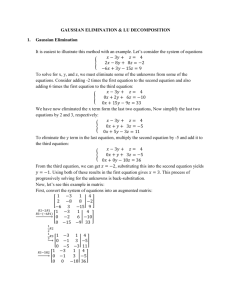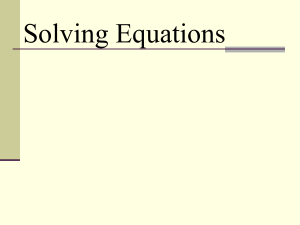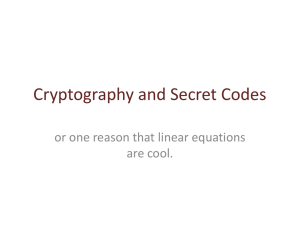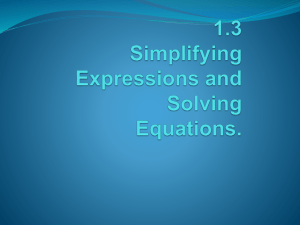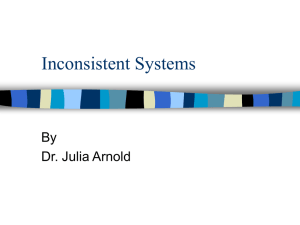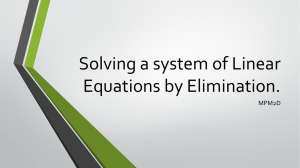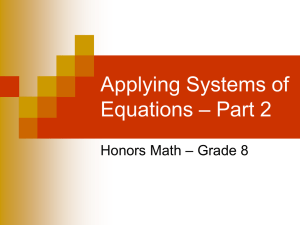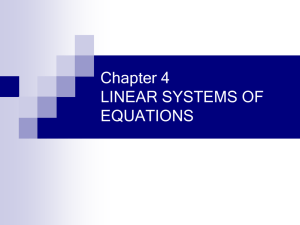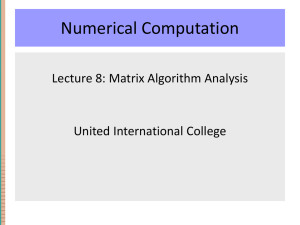Document
advertisement
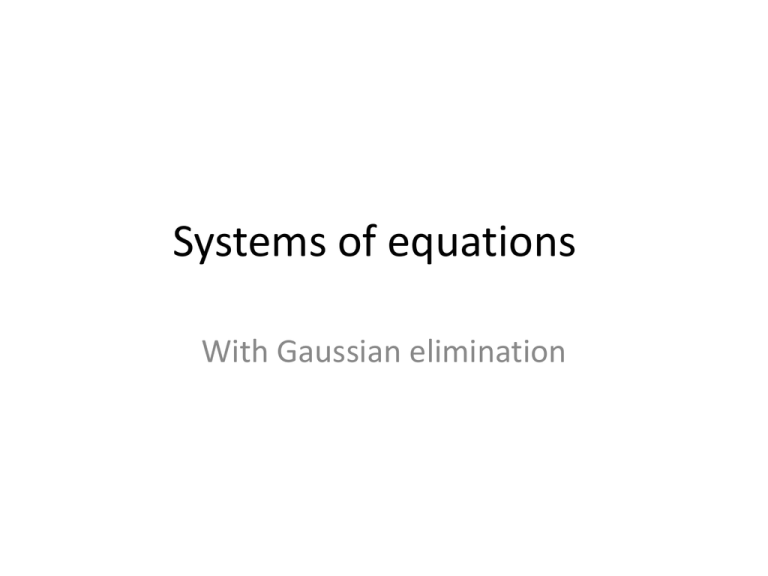
Systems of equations With Gaussian elimination System of equations 4x - 2y = 0 1x + 2y = -5 Find all pairs of x and y values that make the equations true. System of equations 4x - 2y = 0 1x + 2y = -5 1x + 2y = -5 4x - 2y = 0 Swap the order of the rows R1 <-> R2 System of equations 1x + 2y = -5 4x - 2y = 0 -4x - 8y = 20 4x - 2y = 0 Multiply a row by a number -4*R1 R1 System of equations -4x - 8y = 20 4x - 2y = 0 -4x - 8y = 20 0x -10y = 20 Add a row to another row R1 + R2 R2 System of equations -4x - 8y = 20 0x -10y = 20 1x + 2y = -5 0x -10y = 20 Multiply a row by a number -¼*R1 R1 The add-multiply shortcut 1x + 2y = -5 1x + 2y = -5 4x - 2y = 0 0x -10y = 20 Multiply a row by a number and add it to another row -4*R1 + R2 R2 Row operations • • • • Swap rows R1<-> R2 Multiply a row by a number k*R1 R1 Add rows together R1 + R2 R2 Multiply-add shortcut k*R1 + R2 R2 Gaussian Elimination • A method that you can use to solve ANY system of equations (no matter how big), using only two rules. • Multiply a row by a number k*R1 R1 • Multiply-add shortcut k*R1 + R2 R2 How to solve a system of (any number of) linear equations Method: Gaussian Elimination • Today’s fun irrelevant fact: Gauß is my greatgreat-great-great-great-great-great-grandadvisor • Gauß Gerling Plucker Klein Bocher Ford Engen Steffe Thompson Castillo-Garsow The method • Write equations in standard form • Use multiply to get 1x in the top equation • Use multiply-add to get 0x in all other equations. • Use multiply to get 1y in the second equation • Use multiply-add to get 0y in all other equations. • Repeat for all variables. Gaussian Elimination • Get your system in standard form (All the variables on one side, all the constants on the other) 4x + 8y - 4z = 8 2x + 3y + 4z = 4 5x + 8y + 1z = 7 Gaussian Elimination • Use multiply to get 1x in the top equation 4x + 8y - 4z = 8 (1/4) * R1 --> R1 2x + 3y + 4z = 4 5x + 8y + 1z = 7 1x + 2y - 1z = 2 2x + 3y + 4z = 4 5x + 8y + 1z = 7 Gaussian Elimination • Use multiply-add to get 0xs everywhere else 1x + 2y - 1z = 2 2x + 3y + 4z = 4 -2 * R1 + R2 --> R2 5x + 8y + 1z = 7 -5 * R1 + R3 --> R3 1x + 2y - 1z = 2 0x - 1y + 6z = 0 0x - 2y + 6z = -3 Gaussian Elimination • Use multiply to get 1y in the second equation 1x + 2y - 1z = 2 0x - 1y + 6z = 0 -1 * R2 --> R2 0x - 2y + 6z = -3 1x + 2y - 1z = 2 0x + 1y - 6z = 0 0x - 2y + 6z = -3 Gaussian Elimination • Use multiply-add to get 0ys in all other equations • You can do all of these now, but I’m going to put one off for later. 1x + 2y - 1z = 2 0x + 1y - 6z = 0 0x - 2y + 6z = -3 2 * R2 + R3 --> R3 1x + 2y - 1z = 2 0x + 1y - 6z = 0 0x + 0y - 6z = -3 Gaussian Elimination • Use multiply to get 1z in the third equation 1x + 2y - 1z = 2 0x + 1y - 6z = 0 0x + 0y - 6z = -3 (-1/6) * R3 --> R3 1x + 2y - 1z = 2 0x + 1y - 6z = 0 0x + 0y + 1z = 0.5 Gaussian Elimination • Get 0z in all other equations 1x + 2y - 1z = 2 1 * R3 + R1 --> R1 0x + 1y - 6z = 0 6 * R3 + R2 --> R2 0x + 0y + 1z = 0.5 1x + 2y + 0z = 2.5 0x + 1y + 0z = 3 0x + 0y + 1z = 0.5 Gaussian Elimination • Finish my incomplete step • Get 0y in all other equations 1x + 2y + 0z = 2.5 -2 * R2 + R1 --> R1 0x + 1y + 0z = 3 0x + 0y + 1z = 0.5 1x + 0y + 0z = -3.5 0x + 1y + 0z = 3 0x + 0y + 1z = 0.5 Solve the system of equations -3x − 9y = -6 -3x − 13y = -8 a) b) c) d) e) x = -2, y = 0 x = 0, y = 8/13 x = 1/2, y = 1/2 x = -1/2, y = -1/2 None of the above -3x − 9y = -6 (-1/3)*R1 ->R1 -3x − 13y = -8 1x + 3y = 2 -3x − 13y = -8 3R1 + R2 -> R2 1x + 3y = 2 0x − 4y = -2 1x + 3y = 2 0x + 1y = ½ 1x + 0y = 1/2 0x + 1y = 1/2 (-1/4)R2 -> R2 (-3)R2 + R1 -> R1 C -3x − 9y = -6 (-1/3)*R1 ->R1 -3x − 13y = -8 é -3 -9 -6 ù ê ú ë -3 -13 -8 û 1x + 3y = 2 -3x − 13y = -8 3R1 + R2 -> R2 é 1 3 2 ù ê ú ë -3 -13 -8 û 1x + 3y = 2 0x − 4y = -2 é 1 3 2 ù ê ú ë 0 -4 -2 û 1x + 3y = 2 0x + 1y = ½ 1x + 0y = 1/2 0x + 1y = 1/2 (-1/4)R2 -> R2 (-3)R2 + R1 -> R1 é 1 3 2 ù ê ú ë 0 1 0.5 û é 1 0 0.5 ù ê ú ë 0 1 0.5 û What is the system of equations corresponding to the augmented matrix below? a) b) c) d) e) 2x+3y = 4, x + 2y = 3 3x+2y = 4, 2x + y = 3 2x+y = 4, 3x + 2y = 3 x+y = 4, x + 2y = 3 None of the above What is the system of equations corresponding to the augmented matrix below? a) 2x+3y = 4, x + 2y = 3 Solving a system of equations on your calculator (and showing work) • Solve 4x + 8y - 4z = 8 2x + 3y + 4z = 4 5x + 8y + 1z = 7 In my calculator, I set the matrix [A] é 4 8 -4 8 ù ê ú [ A] = ê 2 3 4 4 ú ê 5 8 1 7 ú ë û Then I used the command rref([A]) The calculator output was So the answer is x=-3.5 y=3 z=0.5 é 1 0 0 -3.5 ù ê ú ê 0 1 0 3 ú ê 0 0 1 0.5 ú ë û Special situations • If, at the end you wind up with something impossible, then there are NO SOLUTIONS • Example: é 1 2 4 ù ê ú ë 0 0 1 û The last row: 0x + 0y = 1 is impossible, So there are NO SOLUTIONS. Special situations • If, at the end you wind up with something that is always true, then there are INFINITELY MANY SOLUTIONS • Example: é 1 2 4 ù ê ú ë 0 0 0 û The last row: 0x + 0y = 0 is always true, So there are INFINITELY MANY SOLUTIONS. Solve the following system. a) b) c) d) e) x = 0, y = 3, z = 2 x = 5, y = 3, z = 2 x = 1, y = 3, z = 2 x = -2, y = 3, z = 2 None of the above x=-2 y=3 z=2 D

